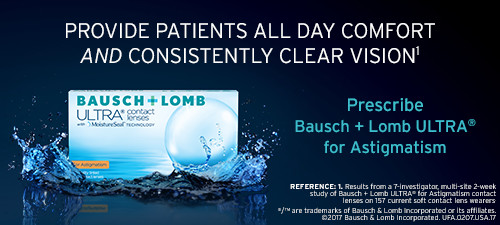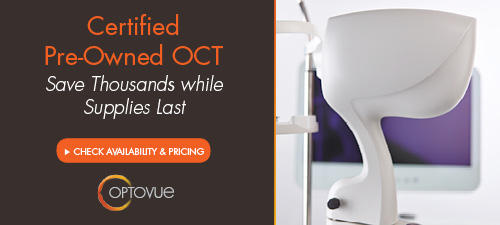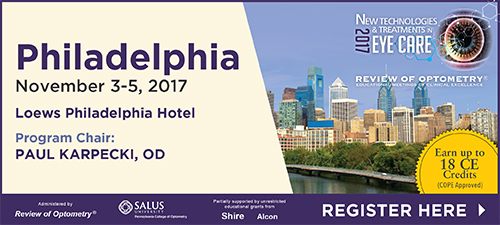
A
weekly e-journal by Art Epstein, OD, FAAO
Off the Cuff: Dr. Parke: Tear Down This Wall
A lot has changed since the Academy of Ophthalmology first banned optometrists from attending its national meeting in 2004. In most states, scope expansion has better aligned optometric practice and education. This has helped further cement optometry’s place as the primary eye care provider in the U.S.
|
|||||
 |
||
| IOP Fluctuations & 24-hour Continuous Monitoring for Glaucoma Risk in Wind Instrument Players | ||||
This study investigated the influence of playing a wind instrument on intraocular pressure (IOP) and monitored 24-hour (IOP) fluctuations in wind musicians of symphony and wind orchestras to compare IOP levels during normal daily activities with IOP levels during playing. Professional and amateur musicians of symphony and wind orchestras were invited to participate. Forty-two participants, nine with glaucoma, underwent a routine ophthalmologic examination. IOP measurements were taken before and immediately after 20 minutes of playing wind instruments. Additionally, six participants underwent 24-hour IOP monitoring with the Triggerfish (Sensimed AG, Switzerland) sensing contact lens, during which they kept an activity logbook.
Eleven professionals and 31 amateur musicians participated in the study. A total of seven eyes of six patients underwent additional 24-hour IOP monitoring. Mean IOP before playing was 13.6mm Hg ± 2.6mm Hg; IOP change after playing was + 1.5mm Hg ± 2.2 mm Hg with a significant difference between professionals (2.5mm Hg ±1.5 mm Hg) and amateurs (1.1mm Hg ± 2.3 mm Hg). There were no significant differences in IOP change between subjects with or without glaucoma. During 24-hour IOP monitoring there were slight increases in IOP while playing an instrument, and during other activities and overnight. These latter IOP levels were similar or even higher than the IOP rise caused by playing a wind instrument. Researchers wrote that IOP often rose after playing wind instruments, but similar or even higher IOP levels seemed to occur during other daily activities or at night. They suggested that these peaks might be relevant for glaucomatous field progression and treatment of glaucoma patients. |
||||
SOURCE: de Crom RMPC, Webers CAB, van Kooten-Noordzij MAW, et al. intraocular pressure fluctuations and 24-hour continuous monitoring for glaucoma risk in wind instrument players. J Glaucoma. 2017; Aug 22. [Epub ahead of print]. |
||||
|
|||
| Peripheral Refraction and Aberration Profiles with Multifocal Lenses | ||||
Investigators wrote that the amount of central or peripheral myopic shift, as induced by different multifocal contact lenses when viewing objects at distance or near, might provide insights on the potential efficacy for slowing eye growth. This study aimed to compare peripheral refraction and higher-order aberration profiles of four multifocal contact lenses with a single vision control lens.
Thirty-five myopes (ages 21.2 years ± 2.1 years) completed the trial, of which 16 wore Air Optix Aqua and Proclear Multifocal Distance and Near (group 1, spherical equivalent: -2.90D ± 0.95D), while 19 wore Air Optix Aqua, Air Optix Multifocal and PureVision Multifocal (group 2, spherical equivalent: -2.95D ± 0.78D). Refraction and aberration profiles with lenses were measured using the BHVI-EyeMapper with (-2.00D to -5.00D in 1.00D steps) and without (+1.00D fogging) accommodation. Data were quantified using M2/4 (2nd and 2nd + 4th order), J0, J45 and higher-order aberration coefficients coma C[3, 1] and spherical aberration C[4, 0]. The center-distance lens exhibited a relative peripheral myopic shift in M2/4 and J0, positive on-axis C[4, 0] and negative on-axis C[3, 1]; and on-axis M4 was less negative for accommodative demands -3.00D. Inversely, the center-near lenses showed a relative peripheral hyperopic shift in M2/4 and J0, negative on-axis C[4, 0] and positive on-axis C[3, 1]; and on-axis M4 was more negative for demands of -2.00D and -3.00D. Independent of lens type, relative peripheral M4 significantly decreased during accommodation. Accounting for C[4, 0], a greater change in relative M profiles and accommodative responses was found for multifocal lenses. Based on the hypothesis that myopic retinal defocus counters eye growth, center-near multifocal lenses exhibited the preferred on-axis features, i.e., producing a central myopic shift at near compared with the control. The center-distance lens exhibited preferred off-axis features, producing relative peripheral myopia, which increased further during accommodation. |
||||
SOURCE: Fedtke C, Ehrmann K, Thomas V, Bakaraju RC. Peripheral refraction and aberration profiles with multifocal lenses. Optom Vis Sci. 2017; Aug 14. [Epub ahead of print]. |
||||
|
|||
| Tear Film Biochemistry Differences of Symptomatic & Asymptomatic Lens Wearers | ||||
Researchers quantified the concentration of selected proteins and inflammatory mediators in tears of symptomatic and asymptomatic contact lens wearers. The level of leukotriene B4 was higher in the symptomatic group, suggesting that inflammation could be the cause of discomfort sensation at the end of day.
This study aimed to quantify the concentration of selected tear lipids and proteins in symptomatic and asymptomatic contact lens wearers. Unstimulated evening tears were collected using glass capillary tubes from 45 healthy, adapted contact lens wearers. Twenty-two had self-described symptoms of dryness and discomfort with contact lenses, and 23 were asymptomatic. Tear proteins were assayed using selected reaction monitoring mass spectrometry; and enzyme immunoassay kits were used to measure prostaglandins, leukotriene B4 and cysteinyl leukotrienes. Ocular comfort was rated on a scale of one to 100 at the time of tear collection. The average evening comfort level was above 70 for the asymptomatic (83.96 ± 9.51, mean ± SE) and equal or below 70 for the symptomatic group (57.28 ± 12.38). LTB4 was significantly higher in symptomatic than asymptomatic contact lens wearers (0.32 ng/μL ± 0.06 ng/μL vs. 0.17 ng/μL ± 0.04 ng/μL, respectively). Lysozyme was slightly but not significantly lower in symptomatic subjects (symptomatic 0.58 ng/μL ± 0.10 mg/mL vs. asymptomatic 1.73 ng/μL ± 0.46 mg/mL). The levels of lactoferrin, lipocalin 1, proline-rich 4, prolactin-induced protein, prostaglandins and cysteinyl leukotrienes were unchanged between symptomatic and asymptomatic subjects. The LTB4 concentration was significantly higher in symptomatic contact lens wearers compared with the asymptomatic group, which might, in part, have mediated the discomfort response during lens wear in the symptomatic lens wearers. No other differences were found in the level of tear factors of interest between the two groups. |
||||
SOURCE: Masoudi S, Stapleton FJ, Willcox MDP. Differences in tear film biochemistry of symptomatic and asymptomatic lens wearers. Optom Vis Sci. 2017; Aug 14. [Epub ahead of print]. |
||||

|
||
| News & Notes | ||||||||
| Post-Market Study of AcuFocus Small Aperture IOL Published AcuFocus announced publication of a European post-market study with its extended depth of focus intraocular lens—the IC-8 small aperture IOL—in the July issue of the Journal of Cataract & Refractive Surgery. The prospective, open-label, multicenter clinical study showed that at six months, visual acuities, safety and patient satisfaction for the IC-8 IOL were excellent. Implantation of the small-aperture IC-8 IOL in one eye and a companion monofocal IOL in the other eye during cataract surgery provided a continuous, uninterrupted range of vision with excellent near and far visual acuities. At six months, uncorrected distance, intermediate and near vision in the IC-8 IOL eyes were 20/23, 20/24 and 20/30 respectively. Binocular vision was 20/32 or better for far, intermediate and near vision in 99 percent, 95 percent and 79 percent of individuals respectively. A high percentage of individuals (95.9 percent) reported they would have the procedure again. The IC-8 IOL is CE marked and available in select European and Asia Pacific markets. A U.S. clinical trial for the IC-8 IOL is expected to begin in 2018. Read more.
|
||||||||
Ophthotech Fails to Achieve Primary Endpoint in Phase III Fovista Trial
|
||||||||
| Alcon Introduces Opti-Free Package Stickers Alcon announced that its U.S. Opti-Free multipurpose solution packaging would soon display a bold pink sticker to help consumers easily identify the brand. The sticker, highlighting the exclusive MPS formula, was expected to be on products sold at nationwide retailers beginning August 27. The Opti-Free portfolio includes Opti-Free Puremoist, Opti-Free Replenish and Opti-Free Express products. Read more.
|
||||||||
|
Optometric Physician™ (OP) newsletter is owned and published by Dr. Arthur Epstein. It is distributed by the Review Group, a Division of Jobson Medical Information LLC (JMI), 11 Campus Boulevard, Newtown Square, PA 19073. HOW TO ADVERTISE |






